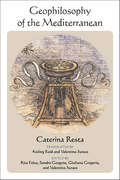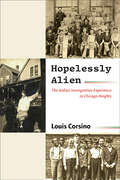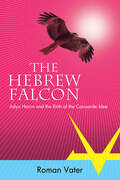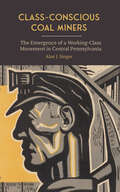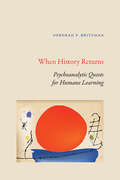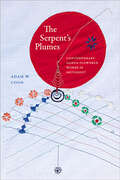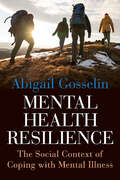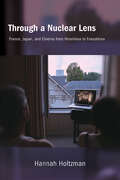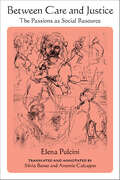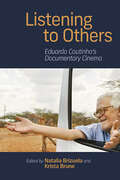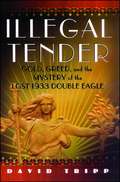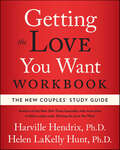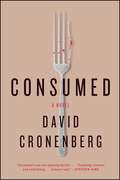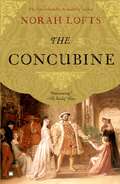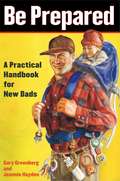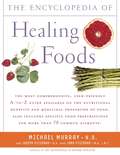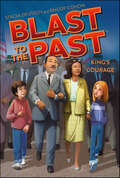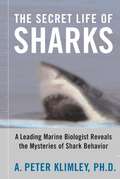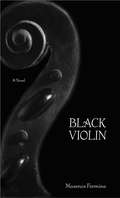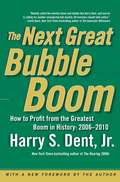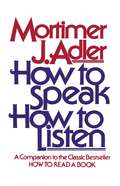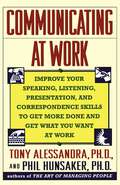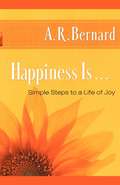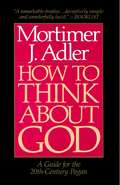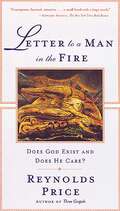- Table View
- List View
Geophilosophy of the Mediterranean (SUNY series in Contemporary Italian Philosophy)
by Caterina RestaThe essays collected here outline a geophilosophy of the Mediterranean—a sea of great importance in the history of Europe and the wider West. Conceived from a geophilosophical perspective, the Mediterranean is a sea surrounded by lands—that is, a "pluriverse" of different cultures and religions, which have often become entangled in conflicts. Nevertheless, they have also demonstrated a remarkable capacity for coexistence, as exemplified by multilingual, multiethnic, and multireligious Sicily during the reign of Roger II of Hauteville. Throughout its millennia-long history, the Mediterranean has consistently displayed a profoundly unified configuration despite its inherent diversity. Its distinctive blend of singularity and plurality can serve as a paradigm for rethinking new forms of social and political coexistence, not only for Europe, which draws its origin from this sea, but also for a new global order.
Hopelessly Alien: The Italian Immigration Experience in Chicago Heights (SUNY series in Italian/American Culture)
by Louis CorsinoHopelessly Alien is an in-depth study of Italian immigration to Chicago Heights, Illinois, between 1910 and 1950. Drawing upon oral histories, interviews, historical documents, and census materials, Louis Corsino examines the critical concept of hope, which most immigration studies have cast in privatized, psychological terms as the motivation to emigrate in search of a better life. This investigation offers a more contentious, sociological perspective, depicting hope as both an ideological lure to recruit and manage the "foreign element" and as a resource immigrants employed to purchase acceptance and avoid a disparaging label as a "hopelessly alien" stranger. These dialectical processes are illustrated through the Italian immigrants' pursuit of occupational mobility and homeownership, and the appropriation of their children's hopes. Each became forms of cultural capital that demonstrated a public commitment to the American ethos of "joyful striving." Each provided measures of success, but these individual pursuits came at the expense of upsetting the necessary tension between individual and communal hopes.
The Hebrew Falcon: Adya Horon and the Birth of the Canaanite Idea
by Roman VaterAdya Gur Horon (1907–1972) was a provocative public intellectual and historical and geopolitical thinker who called for the overthrow of the Israeli non-democratic state-order in favor of an "imperial" Hebrew national vision based on the domination of the whole Levant. Drawing on Horon's private archive, Roman Vater studies the intellectual sources of the mid-twentieth century Hebrew national ideology, known as "Canaanism," contending this vision can only be properly understood in light of Horon's articulation of its historical "foundation myth." The intellectual and political rivalry between Jewish ethnic nationalism and Hebrew civic nationalism, represented by the "Canaanite" challenge to Zionism, continues to inform current debates about Israel’s identity and its relation to world Jewry on the one hand and the Arab world on the other—and largely determines Israel's global political alliances to this day. The Hebrew Falcon is indispensable reading for scholars and students of nationalism, Israel, Zionism, and the intellectual and political history of the modern Middle East.
Class-Conscious Coal Miners: The Emergence of a Working-Class Movement in Central Pennsylvania (SUNY series in Labor Studies)
by Alan J. SingerBituminous coal miners in Central Pennsylvania were among the most militant and class-conscious workers in the United States in the post-World War I era. Class-Conscious Coal Miners examines the development of working-class consciousness as they fought to sustain their union, jobs, communities, and work pejoratives, what they described as the Miner's Freedom, against mechanization and operator open shop drives in the 1920s. Their struggles brought them into conflict with coal companies, a pro-business federal government, and the business-unionist leadership of the United Mine Workers of America. After the collapse of the bituminous coal industry in Central Pennsylvania starting in the 1950s, working-class consciousness gradually diminished until, in the present century, there has been a marked shift toward political conservatism.
When History Returns: Psychoanalytic Quests for Humane Learning (SUNY series, Transforming Subjects: Psychoanalysis, Culture, and Studies in Education)
by Deborah P. BritzmanWhen History Returns brings together psychoanalytic theories of learning with the antinomies of social strife. From a psychoanalytic perspective, history returns through transitional scenes of inheriting a past one could not make, experiencing a present affected by what came before, and facing a future one can neither know nor predict. Taking such scenes as the subject of education, Deborah P. Britzman provides new approaches and vocabulary for conceptualizing experience and understanding, as expressed in psychoanalysis, literature, film, clinical case studies, and warm pedagogy. Britzman argues that novel quests for humane responsibility take hold in the fallout of understanding, in the feel of history, in imaginative dialogues and missed encounters, and in searches for friendship, belonging, and affiliation. Each chapter charts these quests in contemporary education, carrying readers into the heart of learning and the emotional situations that urge the transitions of difficult knowledge into care for thinking and the questions that follow.
The Serpent's Plumes: Contemporary Nahua Flowered Words in Movement (SUNY series, Trans-Indigenous Decolonial Critiques)
by Adam W. CoonThe Serpent's Plumes analyzes contemporary Nahua cultural production, principally bilingual Nahuatl-Spanish xochitlajtoli, or "poetry," written from the 1980s to the present. Adam W. Coon draws on Nahua perspectives as a decolonizing theoretical framework to argue that Nahua writers deploy unique worldviews—namely, ixtlamatilistli ("knowledge with the face," which highlights the value of personal experiences); yoltlajlamikilistli ("knowledge with the heart," which underscores the importance of affective intelligence); and tlaixpan ("that which is in front," which presents the past as lying ahead of a subject rather than behind). The views of ixtlamatilistli, yoltlajlamikilistli, and tlaixpan are key in Nahua struggles and effectively challenge those who attempt to marginalize Native knowledge production.
Mental Health Resilience: The Social Context of Coping with Mental Illness
by Abigail GosselinWhile resilience is traditionally understood as an inner trait that individuals possess inside themselves, Mental Health Resilience argues that resilience should be seen as the product of social factors, where other individuals and institutions provide the resources, opportunities, and support that enable resilience. Resilience is also partly a matter of justice, as people can only be resilient in addressing their vulnerabilities when they are given adequate resources and opportunities, and in just ways. Seen in this light, Abigail Gosselin examines what a person who has mental illness needs to have the resilience required for mental health recovery and for coping with life challenges in general. With its focus on the social and political conditions of resilience, Mental Health Resilience will appeal to fields such as social philosophy, feminist political philosophy, philosophy of psychiatry, medical humanities, bioethics, and disability studies.
Through a Nuclear Lens: France, Japan, and Cinema from Hiroshima to Fukushima (SUNY series, Horizons of Cinema)
by Hannah HoltzmanThe Franco-Japanese coproduction Hiroshima mon amour (1959) is one of the most important films for global art cinema and for the French New Wave. In Through a Nuclear Lens, Hannah Holtzman examines this film and the transnational cycle it has inspired, as well as its legacy after the 2011 nuclear disaster at Fukushima Daiichi. In a study that includes formal and theoretical analysis, archival research, and interviews, Holtzman shows the emergence of a new kind of nuclear film, one that attends to the everyday effects of nuclear disaster and its impact on our experience of space and time. The focus on Franco-Japanese exchange in cinema since the postwar period reveals a reorientation of the primarily aesthetic preoccupations in the tradition of Japonisme to center around technological and environmental concerns. The book demonstrates how French filmmakers, ever since Hiroshima mon amour, have looked to Japan in part to better understand nuclear uncertainty in France.
Between Care and Justice: The Passions as Social Resource (SUNY series in Contemporary Italian Philosophy)
by Elena PulciniElena Pulcini (1950–2021), an internationally renowned philosopher of care, was at the forefront of thinking and creating a new ethical framework to respond efficaciously to problems that affect individuals at a global level. This translation of Pulcini's last work addresses perhaps the two fundamental questions for our times—namely, "Why care for others when we are not bound by personal relationships?" and "Why commit to justice even when it does not personally affect us?" By focusing on passions such as indignation, fear, compassion, resentment, and love, Pulcini offers an alternative ethical perspective in which justice and care intertwine to supplement and balance each other. Together, care and justice are proven capable of addressing the challenge of the "other," distant in space (the outsider, the marginalized, and the migrant) and time (future generations). In the end, Pulcini proposes a form of moral education that nurtures and develops desirable moral sentiments for a more just world at the interpersonal, social, political, economic, and environmental levels, thereby providing an alternative social, global model to current individual-focused, rights-based, purely rationalist ethical systems.
Listening to Others: Eduardo Coutinho's Documentary Cinema (SUNY series in Latin American Cinema)
by Natalia Brizuela; Krista BruneListening to Others is the first English-language volume dedicated solely to the vast corpus of the preeminent Brazilian director, Eduardo Coutinho (1933–2014). From his early work in the 1960s to his last, posthumous film in 2015, Coutinho transformed documentary filmmaking in Brazil and beyond. Described as an informal linguist and savage anthropologist, Coutinho filmed encounters with people different from himself that foregrounded their voices and his role as an attentive listener, creating a "cinema of listening." This collection brings together leading scholars of film, literature, visual culture, Brazilian studies, and Latin American studies, from the United States and Latin America, to examine both Coutinho's masterpieces and less studied films. Using a range of approaches, the contributors invite new ways of understanding the documentarian's trajectory and importance as his work transformed in response to dictatorship, democratization, and other political, social, and technological changes over the course of five decades. The volume also features original translations of a selection of Coutinho's writings and key texts by Brazilian critics to offer a historical perspective on his filmmaking and its reception.
Illegal Tender: Gold, Greed, and the Mystery of the Lost 1933 Double Eagle
by David TrippIt's the most valuable ounce of gold in the world, the celebrated, the fabled, the infamous 1933 double eagle, illegal to own and coveted all the more, sought with passion by men of wealth and with steely persistence by the United States government for more than a half century—it shouldn't even exist but it does, and its astonishing, true adventures read like "a composite of The Lord of the Rings and The Maltese Falcon" (The New York Times). In 1905, at the height of the exuberant Gilded Age, President Theodore Roosevelt commissioned America's greatest sculptor, Augustus Saint-Gaudens—as he battled in vain for his life—to create what became America's most beautiful coin. In 1933 the hopes of America dimmed in the darkness of the Great Depression, and gold—the nation's lifeblood—hemorrhaged from the financial system. As the economy teetered on the brink of total collapse, Franklin Delano Roosevelt, in his first act as president, assumed wartime powers while the nation was at peace and in a "swift, staccato action" unprecedented in United States history recalled all gold and banned its private ownership. But the United States Mint continued, quite legally, to strike nearly a half million 1933 double eagles that were never issued and were deemed illegal to own. In 1937, along with countless millions of other gold coins, they were melted down into faceless gold bars and sent to Fort Knox. The government thought they had destroyed them all—but they were wrong. A few escaped, purloined in a crime—an inside job—that wasn't discovered until 1944. Then, the fugitive 1933 double eagles became the focus of a relentless Secret Service investigation spearheaded by the man who had put away Al Capone. All the coins that could be found were seized and destroyed. But one was beyond their reach, in a king's collection in Egypt, where it survived a world war, a revolution, and a coup, only to be lost again. In 1996, more than forty years later, in a dramatic sting operation set up by a Secret Service informant at the Waldorf-Astoria, an English and an American coin dealer were arrested with a 1933 double eagle which, after years of litigation, was sold in July 2002 to an anonymous buyer for more than $7.5 million in a record-shattering auction. But was it the only one? The lost one? Illegal Tender, revealing information available for the first time, tells a riveting tale of American history, liberally spiced with greed, intrigue, deception, and controversy as it follows the once secret odyssey of this fabulous golden object through the decades. With its cast of kings, presidents, government agents, shadowy dealers, and crooks, Illegal Tender will keep readers guessing about this incomparable disk of gold—the coin that shouldn't be and almost wasn't—until the very end.
Getting the Love You Want Workbook: The New Couples' Study Guide
by Harville Hendrix Helen LaKelly HuntA companion workbook to the New York Times–bestselling book of “time-tested practical steps to [the] love and . . . closeness you deserve” (Daniel J. Siegel, M.D., New York Times–bestselling author of Mindsight).This newly revised and updated companion study guide to the 2019 edition of the New York Times bestseller Getting the Love You Want.In 1988, Harville Hendrix, in partnership with his wife, Helen LaKelly Hunt, published a terrifically successful relationship guide called Getting the Love You Want. The book introduced thousands to their Imago Relationship Therapy, a unique healing process for couples, prospective couples, and parents, and developed into an overnight sensation. Now, more than a decade later, this companion book picks up where its predecessor left off, delving further into relationship therapy to help transform relationships into lasting sources of love and companionship.The Getting the Love You Want Workbook is designed for couples who have attended Imago workshops, as well as new and curious ones seeking a practical route back to intimacy and passionate friendship. The workbook contains a unique twelve-week course (The New Couples’ Study Guide) designed to help work through the exercises published in Part III of Getting the Love You Want.For those of us struggling to maintain our most precious relationships, the Getting the Love You Want Workbook helps us grow aware of our individual, unconscious agenda while steering us towards a more harmonious link with our loved ones.“What a treasure this book is, full of the insight, wisdom, and empathy that enriches loving relationships, even those that may seem worn at the seams or beyond hope.” —Diane Ackerman, New York Times–bestselling author of A Natural History of Love
Consumed: A Novel
by David Cronenberg“An eye-opening dazzler” (Stephen King) about a pair of globetrotting, gore-obsessed journalists whose entanglement in a French philosopher’s death becomes a surreal journey into global conspiracy from legendary filmmaker David Cronenberg.Stylish and camera-obsessed, Naomi and Nathan thrive on the yellow journalism of the social-media age. Naomi finds herself drawn to the headlines surrounding a famous couple, Célestine and Aristide, Marxist philosophers and sexual libertines. Célestine has been found dead, and Aristide has disappeared. Police suspect him of killing her and consuming parts of her body. Yet Naomi sets off to find him, and as she delves deeper into the couple’s lives, she discovers the news story may only skim the surface of the disturbing acts they performed together.Journalist Nathan, meanwhile, is in Budapest photographing the controversial work of an unlicensed surgeon named Zoltán Molnár, once sought by Interpol for organ trafficking. After sleeping with one of Molnár’s patients, Nathan contracts a rare STD called Roiphe’s and travels to Toronto, determined to meet the man who discovered the syndrome. Dr. Barry Roiphe, Nathan learns, now studies his own adult daughter, whose bizarre behavior masks a devastating secret.These parallel narratives become entwined in a gripping, dreamlike plot that involves geopolitics, 3-D printing, North Korea, the Cannes Film Festival, cancer, and, in an incredible number of varieties, sex. Consumed is an exuberant, provocative debut novel from one of the world’s leading film directors, a writer of “fierce sculptural intensity” (Jonathan Lethem, The New York Times Book Review) who makes it “impossible to look away” (Publishers Weekly).
The Concubine: A Novel
by Norah LoftsAcclaimed and beloved historical novelist Norah Lofts brings to life the danger, romance, and intrigue of the Tudor court that forever altered the course of English history. The king first noticed Anne Boleyn as a heartbroken sixteen-year-old, sullen and beautiful after a thwarted romance with the son of the Earl of Northumberland. "All eyes and hair," a courtier had said disparagingly of her, but when King Henry VIII fell for young Anne, nothing could keep him from what he desired. Against common sense and the urgings of his most trusted advisors, Henry defied all, blindly following his passion for Anne, using the power he held over the bodies and souls of all who reside in his realm and beyond. Anne's ascent to the throne elevates her from lady-in-waiting to the highest position a woman could attain, but her life spirals out of control when Henry is driven to desperate acts of betrayal and violence. The consequences of Anne's rise to power and eventual demise are felt well beyond the inner circle of the court. Loyalties, to church, to queen, to country, are tested, and -- in the wake of the king's volatile passions -- can be an unpredictable matter of life and death. First published in 1963 and adored by readers for generations, Lofts' lush and moving portrayal of the ambitious and doomed Anne Boleyn will continue to reign as a classic retelling of this epic chapter of history vividly brought to life.
Be Prepared: A Practical Handbook for New Dads
by Gary Greenberg Jeannie HaydenAn indispensable survival manual for men entering the trenches of fatherhood, Be Prepared is loaded with one-of-a-kind insights, MacGyver-esque tips and tricks, and no-nonsense advice for mastering the first year as a dad.Finally, a book that teaches men all the things they really need to know about fatherhood...including how to: -Change a baby at a packed sports stadium -Create a decoy drawer full of old wallets, remote controls, and cell phones to throw baby off the scent of your real gear -Stay awake (or at least upright) at work -Babyproof a hotel room in four minutes flat -Construct an emergency diaper out of a towel, a sock, and duct tape Packed with helpful diagrams and detailed instructions, and delivered with a wry sense of humor, Be Prepared is the ultimate guide for sleep-deprived, applesauce-covered fathers everywhere.
The Encyclopedia of Healing Foods
by Michael T. Murray Joseph PizzornoFrom the bestselling authors of The Encyclopedia of Natural Medicine, the most comprehensive and practical guide available to the nutritional benefits and medicinal properties of virtually everything edible As countless studies have affirmed, diet plays a major role in both provoking and preventing a wide range of diseases. But just what is a healthy diet? What does the body need to stay strong and get well? In The Encyclopedia of Healing Foods, Michael T. Murray, N.D., and Joseph Pizzorno, N.D., two of the world¹s foremost authorities on nutrition and wellness, draw on an abundant harvest of research to present the best guide available to healthy eating. Make healthy eating a lifetime habit. Let The Encyclopedia of Healing Foods teach you how to: design a safe diet use foods to stimulate the body¹s natural ability to rejuvenate and heal discover the role that fiber, enzymes, fatty acids, and other dietary components have in helping us live healthfully understand which food prescriptions will help you safely treat more than 70 specific ailments, including acne, Alzheimer¹s disease, immune system depression, insomnia, migraine headaches, PMS, and rheumatoid arthritis prepare foods safely in order to prevent illness and maximize health benefits select, store, and prepare all kinds of healthful foods Providing the best natural remedies for everyday aches and pains, as well as potent protection against serious diseases, The Encyclopedia of Healing Foods is a required daily health reference.
King's Courage (Blast to the Past #4)
by Stacia Deutsch Rhody CohonThe Blast to the Past gang gets the chance to impact civil rights when they meet Dr. Martin Luther King, Jr., and give him their vote of confidence in this fourth book in the Blast to the Past series.It’s another exciting Monday for Abigail, Zack, Jacob, and Bo—they are going to jump back to the past to meet Dr. Martin Luther King, Jr.! The kids need to convince Dr. King not to get discouraged and to lead one of his famous voting rights marches. And they’ve got to do it with the twins’ baby brother, Gabe, in tow!This mission will be more challenging—and more surprising—than any that they’ve faced so far. Luckily, they’ll get some help from two very special people...
The Secret Life of Sharks: A Leading Marine Biologist Reveals the Mysteries of Shark Behavior
by A. Peter KlimleyMarine biologist Pete Klimley swims with the sharks. He was one of the first scientists to free-dive among sharks, and he has spent nearly thirty years studying shark behavior, sometimes swimming in schools of several hundred sharks. From his firsthand observations he has learned that sharks are not the vicious man-eaters that we imagine, but fascinating animals with complex behaviors.Most people who think of sharks at all think immediately of great white sharks. But there are more than four hundred species of shark. Dr. Klimley has studied several species, most notably the great white and the hammerhead. (He describes the great white as the athlete among sharks, and the hammerhead as the Ph.D. of the shark world.) In The Secret Life of Sharks Dr. Klimley reveals the significant discoveries he made about hammerhead navigation and great white eating habits. By studying hammerheads gathered around underwater seamounts, Dr. Klimley learned that hammerheads rely on sophisticated tracking of ocean-floor magnetism to navigate. His long-term study of great white sharks off the California coast demonstrated that these huge sharks prefer to eat seals and sea lions because of the energy contained in their fatty bodies. They are selective eaters, not the man-eaters we expect, and they sometimes go weeks between meals. But Dr. Klimley did observe a ritualized behavior that great whites practice in order to avoid deadly disputes over prey that one shark has captured and another wants.Although we have learned a great deal about shark behavior, says Dr. Klimley, there is much that we do not know. Unfortunately we are destroying these magnificent creatures of the deep through overfishing and degradation of the oceans. Already some populations of sharks have declined steeply.Vividly written by one of the foremost authorities on sharks, The Secret Life of Sharks is a fascinating account of some of the world's most magnificent animals.
Black Violin: A Novel
by Maxence FermineThere were many musical souls adrift on that raft of silence that is Venice. There was the music of Johannes Karelsky.There was the music of Erasmus, the violin maker. And there was the music of war. But of that, the two men never spoke.From the internationally acclaimed author of Snow comes a timeless tale of love and music set against the romantic backdrop of eighteenth-century Venice.In 1797, the violin prodigy Johannes Karelsky arrives in Venice after fighting with Napoleon's army in the Italian campaign. After the war, he boards with an aged violin maker named Erasmus who created the legendary "Black Violin," which he forbids Johannes to touch because, as he says, "Once you have tasted it, you will never be the same again." Johannes becomes obsessed with the idea of playing this violin as well as finding the woman who saved his life when he was injured in battle.Beautifully written and highly evocative, The Black Violin interweaves Johannes's quest for love and the history of this mysterious instrument in a narrative that is sure to resonate long after the last page is turned.
The Next Great Bubble Boom: How to Profit from the Greatest Boom in History: 2006–2010
by Harry S. Dent Jr.For over fifteen years, New York Times bestselling author Harry S. Dent, Jr., has been uncannily accurate in predicting the financial future. In his three previous works, Dent predicted the financial recession of the early nineties, the economic expansion of the mid-nineties, and the financial free-for-all of 1998-2000.The Next Great Bubble Boom -- part crystal ball, part financial planner -- offers a comprehensive forecast for the next two decades, showing new models for predicting the future behavior of the economy, inflation, large- and small-cap stocks, bonds, key sectors, and so on. In taking a look at past booms and busts, Dent compares our current state to that of the crash of 1920-21, and the years ahead of us to the Roaring Twenties. Dent gives advice on everything from investment strategies to real estate cycles, and shows not only how bright our future will be but how best to profit from it.Dent gives us all something to look forward to, including:The Dow hitting 40,000 by the end of the decade The Nasdaq advancing at least ten times from its October 2001 lows to around 13,500, and potentially as high as 20,000 by 2009 Another strong advance in stocks in 2005, with a significant correction into around September/October 2006 The Great Boom resurging into its final and strongest stage in 2007, and even more fully in 2008, lasting until late 2009 to early 2010Dent's amazing ability to track and forecast our financial future is renowned, and here he takes that ability to the next level, showing not only what our economy will look like but also how it will affect us as individuals, as organizations, and as a culture. From the upcoming wealth revolution to the essential principles of entrepreneurial success, the book describes a new society where economic and philanthropic development go hand in hand. In The Next Great Bubble Boom, Dent shows not only how the economic growth of the late 1990s was a prelude to the true great boom right around the corner but how all of us can reap its benefits.
How to Speak How to Listen
by Mortimer J. AdlerFrom the author of the bestselling How to Read a Book comes a comprehensive and practical guide for learning how to speak and listen more effectively.With over half a million copies in print of his &“living classic&” How to Read a Book in print, intellectual, philosopher, and academic Mortimer J. Adler set out to write an accompanying volume on speaking and listening, offering the impressive depth of knowledge and accessible panache that distinguished his first book. In How to Speak How to Listen, Adler explains the fundamental principles of communicating through speech, with sections on such specialized presentations as the sales talk, the lecture, and question-and-answer sessions and advice on effective listening and learning by discussion.
Communicating at Work
by Tony Alessandra Phil HunsakerIn today's competitive workplace, your ability to communicate is your most important business skill.This valuable handbook to better business communication can help you develop the skills you need to succeed. Using real-life examples, it offers practical, easy-to-use instruction in writing effective memos and reports, making memorable presentations, and leading productive meetings. It also introduces key telephone skills, shows you how to interpret body language and personal communication styles -- and teaches you the critical listening and questioning skills you need to get ahead.Whether you're a top manager trying to lead a large organization or one of the millions of people who actually get the work done, Communicating at Work can help you be more effective, get more of what you want out of work, and improve your chances for success.
Happiness Is . . .: Simple Steps to a Life of Joy
by A. R. BernardIf money doesn't buy happiness, what does? From the founder and spiritual leader of the 28,000-member New York Christian Cultural Center comes a powerful tool that can help anyone escape the grip of negativity and achieve the spiritual prosperity that can come only with discipline and wisdom.Drawing on scripture, common sense, and inspirational quotes from an army of luminaries that includes Billy Graham, Mother Theresa, Quincy Jones, and Rick Warren, Happiness Is... explains what happiness is, how to find it, and how to keep it. "Happiness isn't a commodity that can be purchased in a store" counsels Bernard. "It's a by-product of the way you choose to live and the things you choose to think."Happiness Is... teaches you not to worry about things you can't control and instead inspires you to use the talents that God has already given you to lead a purposeful, principled life. Are you ready to celebrate your life today? God's love for you is infinite. Accept it joyfully...and be happy now.
How to Think About God: A Guide for the 20th-Century Pagan
by Mortimer J. AdlerDr. Adler, in his discussion, extends and modernizes the argument for the existence of God developed by Aristotle and Aquinas. Without relying on faith, mysticism, or science (none of which, according to Dr. Adler, can prove or disprove the existence of God), he uses a rationalist argument to lead the reader to a point where he or she can see that the existence of God is not necessarily dependent upon a suspension of disbelief. Dr. Adler provides a nondogmatic exposition of the principles behind the belief that God, or some other supernatural cause, has to exist in some form. Through concise and lucid arguments, Dr. Adler shapes a highly emotional and often erratic conception of God into a credible and understandable concept for the lay person.
Letter to a Man in the Fire: Does God Exist and Does He Care?
by Reynolds PriceDoes God Exist and Does He Care?In April 1997 Reynolds Price received an eloquent letter from a reader of his cancer memoir, A Whole New Life. The correspondent, a young medical student diagnosed with cancer himself and facing his own mortality, asked these difficultQuestions. The two began a long-distance correspondence, culminating in Price's thoughtful response, originally delivered as the Jack and Lewis Rudin Lecture at Auburn Theological Seminary, and now expanded onto the printed page as Letter to a Man in the Fire.Harvesting a variety of sources -- diverse religious traditions, classical and modern texts, and a lifetime of personal experiences, interactions, and spiritual encounters -- Price meditates on God's participation in our fate. With candor and sympathy, he offers the reader such a rich variety of tools to explore these questions as to place this work in the company of other great tetsaments of faith from St. Augustine to C. S. Lewis.Letter to a Man in the Fire moves as much as it educates. It is a rare combination of deep erudition, vivid prose, and profound humanity.
